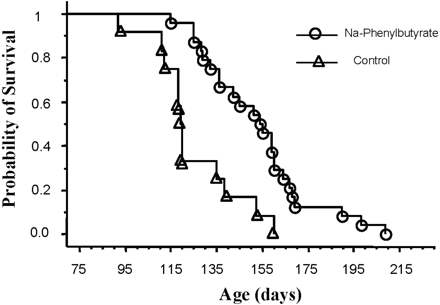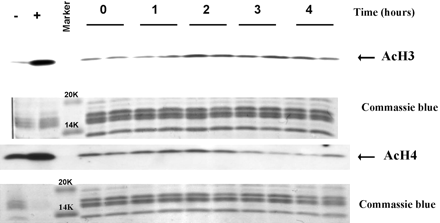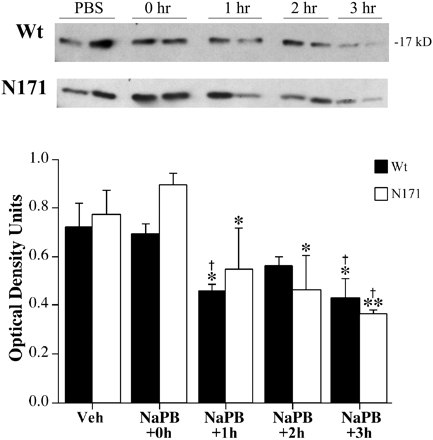4-PBA sodium; Sodium 4-phenylbutyrate; Sodium phenylbutyrate; 4-phenylbutyrate (4-PBA); Sodium 4-phenylbutyrate; SODIUM PHENYLBUTYRATE; 1716-12-7; sodium 4-phenylbutanoate; Buphenyl; Ammonaps; Benzenebutanoic acid, sodium salt; TriButyrate; 4-phenylbutyric acid; Buphenyl

| Size | Price | Stock | Qty |
|---|---|---|---|
| 100mg |
|
||
| 500mg |
|
||
| 1g |
|
||
| 2g |
|
||
| 5g |
|
||
| 10g |
|
||
| Other Sizes |
Purity: ≥98%
Sodium phenylbutyrate (4-Phenylbutyric acid sodium; 4-PBA sodium), an orphan drug marketed by Ucyclyd Pharma, is a novel and potent histone deacetylase (HDAC) inhibitor used as an as adjunctive therapy for chronic treatment of urea cycle disorders involving deficiencies of argininosuccinic acid synthetase (AS), ornithine transcarbamylase (OTC), or carbamylphosphate synthetase (CPS). Because metabolites of sodium phenylbutyrate offer an alternative pathway to the urea cycle for the excretion of excess nitrogen. It has strong anti-cancer properties as well.
| Targets |
HDAC/Histone Deacetylases
|
|
|---|---|---|
| ln Vitro |
|
|
| ln Vivo |
|
|
| Enzyme Assay |
Phenylbutyrate (PB) is a histone deacetylase inhibitor that has been shown to induce differentiation and apoptosis in various cancer cell lines. Although these effects are most likely due to modulation of gene expression, the specific genes and gene products responsible for the effects of PB are not well characterized. In this study, we used cDNA expression arrays and Western blot to assess the effect that PB has on the expression of various cancer and apoptosis-regulatory gene products. We show that PB attenuates the expression of the apoptosis antagonist Bcl-X(L), the double-strand break repair protein DNA-dependent protein kinase, the prostate progression marker caveolin-1, and the pro-angiogenic vascular endothelial growth factor. Furthermore, PB was found to act in synergy with ionizing radiation to induce apoptosis in prostate cancer cells. Taken together, our results point to the possibility that PB may be an effective anti-prostate cancer agent when used in combination with radiation or chemotherapy and for the inhibition of cancer progression.[2]
|
|
| Cell Assay |
In brief, viable cells are seeded at a density of 4 × 104 cells/mL in 60-mm dishes in RPMI 1640 with 10% fetal bovine serum and 0.35% agarose on a base layer of 0.7% agarose. Viable cells are determined by trypan blue dye exclusion. Additions of DMSO, TSA, or PB are made to the upper and lower agarose layers. Colonies are counted after 10–14 days, and assays are run in triplicate at least three times.
|
|
| Animal Protocol |
|
|
| Toxicity/Toxicokinetics |
Effects During Pregnancy and Lactation
◉ Summary of Use during Lactation No information is available on the clinical use of sodium phenylbutyrate or the combination of sodium phenylbutyrate and taurursodiol during breastfeeding. Both sodium phenylbutyrate and taurursodiol are highly protein bound and therefore unlikely to enter milk in clinically important amounts. If sodium phenylbutyrate with or without taurursodiol is required by the mother, it is not a reason to discontinue breastfeeding. Until more data become available, these products should be used with caution during breastfeeding, especially while nursing a newborn or preterm infant. Monitoring the breastfed infant for neurotoxicity (excessive sedation, vomiting) during maternal therapy may be advisable. ◉ Effects in Breastfed Infants Relevant published information was not found as of the revision date. ◉ Effects on Lactation and Breastmilk Relevant published information was not found as of the revision date. |
|
| References | ||
| Additional Infomation |
Sodium phenylbutyrate is the organic sodium salt of 4-phenylbutyric acid. A prodrug for phenylacetate, it is used to treat urea cycle disorders. It has a role as a prodrug, an EC 3.5.1.98 (histone deacetylase) inhibitor, a neuroprotective agent, an orphan drug and a geroprotector. It contains a 4-phenylbutyrate.
Sodium Phenylbutyrate is the sodium salt of phenylbutyrate, a derivative of the short-chain fatty acid butyrate, with potential antineoplastic activity. Phenylbutyrate reversibly inhibits class I and II histone deacetylases (HDACs), which may result in a global increase in gene expression, decreased cellular proliferation, increased cell differentiation, and the induction of apoptosis in susceptible tumor cell populations. See also: Phenylbutyric acid (has active moiety); Sodium phenylbutyrate; taurursodiol (component of). Drug Indication Ammonaps is indicated as adjunctive therapy in the chronic management of urea cycle disorders, involving deficiencies of carbamylphosphate synthetase, ornithine transcarbamylase orargininosuccinate synthetase. It is indicated in all patients with neonatal-onset presentation (complete enzyme deficiencies, presenting within the first 28 days of life). It is also indicated in patients with late-onset disease(partial enzyme deficiencies, presenting after the first month of life) who have a history of hyperammonaemic encephalopathy. Treatment of chronic management of urea-cycle disorders. |
| Molecular Formula |
C10H11O2.NA
|
|
|---|---|---|
| Molecular Weight |
186.18
|
|
| Exact Mass |
186.065
|
|
| Elemental Analysis |
C, 64.51; H, 5.96; Na, 12.35; O, 17.19
|
|
| CAS # |
1716-12-7
|
|
| Related CAS # |
1821-12-1 (free acid); 1716-12-7 (Sodium) 4-Phenylbutyric acid-d11;358730-86-6;4-Phenylbutyric acid-d5;64138-52-9;4-Phenylbutyric acid-d2;461391-24-2
|
|
| PubChem CID |
5258
|
|
| Appearance |
White to off-white solid powder
|
|
| Density |
1.095g/cm3
|
|
| Boiling Point |
290.7ºC at 760mmHg
|
|
| Melting Point |
207 °C (dec.)(lit.)
|
|
| Flash Point |
187.9ºC
|
|
| Vapour Pressure |
0.00288mmHg at 25°C
|
|
| LogP |
0.759
|
|
| Hydrogen Bond Donor Count |
0
|
|
| Hydrogen Bond Acceptor Count |
2
|
|
| Rotatable Bond Count |
4
|
|
| Heavy Atom Count |
13
|
|
| Complexity |
142
|
|
| Defined Atom Stereocenter Count |
0
|
|
| SMILES |
[Na+].[O-]C(C([H])([H])C([H])([H])C([H])([H])C1C([H])=C([H])C([H])=C([H])C=1[H])=O
|
|
| InChi Key |
VPZRWNZGLKXFOE-UHFFFAOYSA-M
|
|
| InChi Code |
InChI=1S/C10H12O2.Na/c11-10(12)8-4-7-9-5-2-1-3-6-9;/h1-3,5-6H,4,7-8H2,(H,11,12);/q;+1/p-1
|
|
| Chemical Name |
sodium;4-phenylbutanoate
|
|
| Synonyms |
|
|
| HS Tariff Code |
2934.99.9001
|
|
| Storage |
Powder -20°C 3 years 4°C 2 years In solvent -80°C 6 months -20°C 1 month Note: Please store this product in a sealed and protected environment, avoid exposure to moisture. |
|
| Shipping Condition |
Room temperature (This product is stable at ambient temperature for a few days during ordinary shipping and time spent in Customs)
|
| Solubility (In Vitro) |
|
|||
|---|---|---|---|---|
| Solubility (In Vivo) |
Solubility in Formulation 1: 100 mg/mL (537.11 mM) in PBS (add these co-solvents sequentially from left to right, and one by one), clear solution; with sonication.
(Please use freshly prepared in vivo formulations for optimal results.) |
| Preparing Stock Solutions | 1 mg | 5 mg | 10 mg | |
| 1 mM | 5.3711 mL | 26.8557 mL | 53.7115 mL | |
| 5 mM | 1.0742 mL | 5.3711 mL | 10.7423 mL | |
| 10 mM | 0.5371 mL | 2.6856 mL | 5.3711 mL |
*Note: Please select an appropriate solvent for the preparation of stock solution based on your experiment needs. For most products, DMSO can be used for preparing stock solutions (e.g. 5 mM, 10 mM, or 20 mM concentration); some products with high aqueous solubility may be dissolved in water directly. Solubility information is available at the above Solubility Data section. Once the stock solution is prepared, aliquot it to routine usage volumes and store at -20°C or -80°C. Avoid repeated freeze and thaw cycles.
Calculation results
Working concentration: mg/mL;
Method for preparing DMSO stock solution: mg drug pre-dissolved in μL DMSO (stock solution concentration mg/mL). Please contact us first if the concentration exceeds the DMSO solubility of the batch of drug.
Method for preparing in vivo formulation::Take μL DMSO stock solution, next add μL PEG300, mix and clarify, next addμL Tween 80, mix and clarify, next add μL ddH2O,mix and clarify.
(1) Please be sure that the solution is clear before the addition of next solvent. Dissolution methods like vortex, ultrasound or warming and heat may be used to aid dissolving.
(2) Be sure to add the solvent(s) in order.
| NCT Number | Recruitment | interventions | Conditions | Sponsor/Collaborators | Start Date | Phases |
| NCT06069375 | Recruiting | Drug: Sodium phenylbutyrate | Medium-chain Acyl-CoA Dehydrogenase Deficiency |
Jerry Vockley, MD, PhD | December 2023 | Phase 2 |
| NCT02111200 | Completed | Drug: Sodium Phenylbutyrate Drug: Sodium Benzoate |
Urea Cycle Disorders, Inborn | Baylor College of Medicine | September 2014 | Not Applicable |
| NCT01529060 | Completed | Drug: Phenylbutyrate Drug: Placebo powder |
Maple Syrup Urine Disease | Brendan Lee | February 2013 | Phase 2 Phase 3 |
| NCT00107770 | Completed | Drug: sodium phenylbutyrate | Amyotrophic Lateral Sclerosis | US Department of Veterans Affairs |
April 2005 | Phase 1 Phase 2 |
 |
|---|
 |
 |